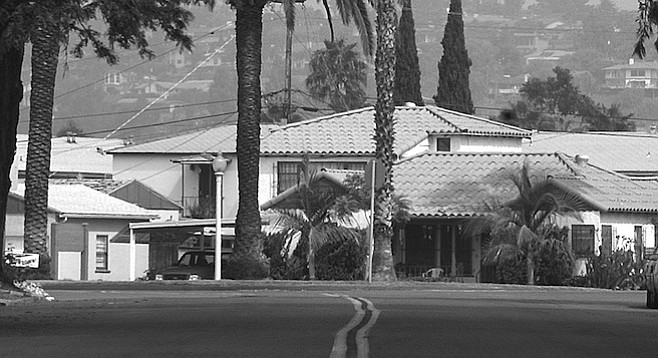Here's something you might be interested in.
Get Involved
 Facebook
Facebook
 X
X
 Instagram
Instagram
 TikTok
TikTok
 Youtube
Youtube

A sense of humanity pervades this little community on San Diego’s eastern fringe, a sense that beauty matters to the souls of all men, not just those who can afford La Jolla. Though the name Rolando has come to include everything between College Avenue to the west, El Cajon Boulevard to the north, the city of La Mesa to the east, and University Avenue to the south, the original neighborhood is the eight to ten blocks centered around the four-way-stop intersection of Solita Avenue and Rolando Boulevard. Stamped on the sidewalk on the southwest corner is the name “G. R. Daley” and the date “8-27.”
I don’t know if Mr. Daley built just the sidewalks — the old style with a strip of dirt between the sidewalk and the street for grass or gardens — or if he built the streets and houses too. But the date seems right for this area. In 1927, the Great War had been won nine years earlier and the stock market was two years from crashing. While Europe still licked its wounds, American pride and sense of possibility soared. And I imagine that G. R. Daley and the other men who constructed Rolando wanted to build a neighborhood that reflected that new sense of national joy. If so, they succeeded.
They built ornate concrete gas lamps to illuminate the streets and sidewalks at night. They planted trees along the avenues to green up the neighborhood by day. As you enter from the north on Rolando Boulevard, towering silk oak trees 90 feet tall line both sides of the road. The men made the streets narrow for an intimate feel, with gentle curves that follow the natural contours of the landscape. They gave the streets Spanish names such as Aragon, Serrano, and Valencia. They built staircases that pedestrians could use to shortcut between streets. And they built small but picturesque houses that a veteran of the Great War would be proud to come home to.
Almost all of the houses in Rolando are less than 1500 square feet. Those that are larger have had additions that mar the quaint symmetry Mr. Daley and his cohorts crafted so carefully. They sit centered on modest-sized lots, evenly spaced from each other. Styles include Cape Cod, Spanish Colonial, French cottage, and a sort of Mediterranean bungalow. Smooth, hand-troweled exteriors are the rule, as opposed to rough, sprayed-on stucco. The houses are on raised foundations, not concrete slabs, and have hardwood floors and wood-framed windows. Even today, the houses look fresh and inviting.
The pride that was put into building Rolando lives on today in its residents. Though you see few gardeners’ trucks parked at the curb, you see well-maintained gardens. Some are spectacular. I can think of only one house that has fallen into serious disrepair. On a recent tour through the neighborhood I saw a single “For Sale” sign. It’s a place people don’t want to leave.


A sense of humanity pervades this little community on San Diego’s eastern fringe, a sense that beauty matters to the souls of all men, not just those who can afford La Jolla. Though the name Rolando has come to include everything between College Avenue to the west, El Cajon Boulevard to the north, the city of La Mesa to the east, and University Avenue to the south, the original neighborhood is the eight to ten blocks centered around the four-way-stop intersection of Solita Avenue and Rolando Boulevard. Stamped on the sidewalk on the southwest corner is the name “G. R. Daley” and the date “8-27.”
I don’t know if Mr. Daley built just the sidewalks — the old style with a strip of dirt between the sidewalk and the street for grass or gardens — or if he built the streets and houses too. But the date seems right for this area. In 1927, the Great War had been won nine years earlier and the stock market was two years from crashing. While Europe still licked its wounds, American pride and sense of possibility soared. And I imagine that G. R. Daley and the other men who constructed Rolando wanted to build a neighborhood that reflected that new sense of national joy. If so, they succeeded.
They built ornate concrete gas lamps to illuminate the streets and sidewalks at night. They planted trees along the avenues to green up the neighborhood by day. As you enter from the north on Rolando Boulevard, towering silk oak trees 90 feet tall line both sides of the road. The men made the streets narrow for an intimate feel, with gentle curves that follow the natural contours of the landscape. They gave the streets Spanish names such as Aragon, Serrano, and Valencia. They built staircases that pedestrians could use to shortcut between streets. And they built small but picturesque houses that a veteran of the Great War would be proud to come home to.
Almost all of the houses in Rolando are less than 1500 square feet. Those that are larger have had additions that mar the quaint symmetry Mr. Daley and his cohorts crafted so carefully. They sit centered on modest-sized lots, evenly spaced from each other. Styles include Cape Cod, Spanish Colonial, French cottage, and a sort of Mediterranean bungalow. Smooth, hand-troweled exteriors are the rule, as opposed to rough, sprayed-on stucco. The houses are on raised foundations, not concrete slabs, and have hardwood floors and wood-framed windows. Even today, the houses look fresh and inviting.
The pride that was put into building Rolando lives on today in its residents. Though you see few gardeners’ trucks parked at the curb, you see well-maintained gardens. Some are spectacular. I can think of only one house that has fallen into serious disrepair. On a recent tour through the neighborhood I saw a single “For Sale” sign. It’s a place people don’t want to leave.
Comments